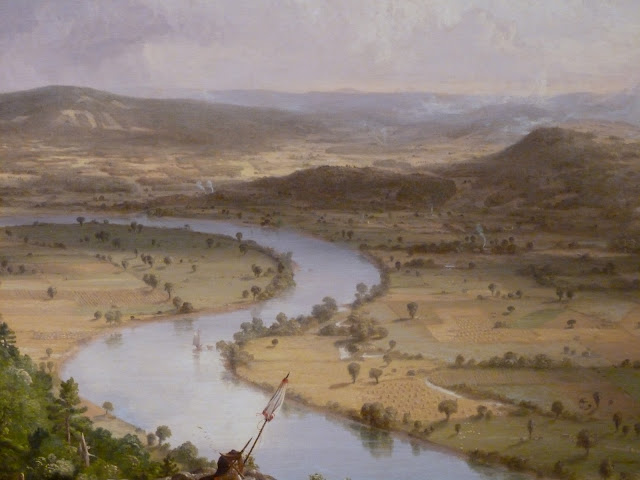Here are some photos I took in 2015 of another major painting by Thomas Cole featured in the small show of his work in the Metropolitan Museum, The Oxbow, or more properly known by its official title View from Mount Holyoke, Northhampton, Massachusetts after a Thunderstrom, the Oxbow painted in 1836.
These are all my photos unless otherwise noted and are freely available, especially to educators.
This painting normally sits prominently displayed in a gallery of the first generation Hudson River School painters in the Museum
Thomas Cole painted a deeply Romantic painting of a particular place seen not literally but through memory and imagination. As in The Course of Empire, the painting beautifully expresses Cole's ambivalent feelings about the development of the North American wilderness. Cole was not a tree-hugger. He was all for development. But, he felt that the way the wilderness was being cleared was rapacious. Far from prelapsarian visions of yeomen farmers cutting down the trees and clearing the brush to make room for farming, timber companies, railroads, and commercial farming clearcut whole forests at a time. On another deeper level, Cole felt deeply the loss of primordial wilderness was indeed a loss, and that comes through in this painting.
A mighty storm damaged oak in the foreground seems to sweep aside the thunderstorm to reveal a sunlit valley of new settlement; like Donner clearing away the storm clouds to reveal the newly built Valhalla in the sunlight in the last scene of Das Rheingold.
The storm, still raging, passes off into the wilderness on the left. The wilderness in this painting is powerful and frightening.
The storm was incredibly powerful. Much of the damage on the oak tree is new. Cole shows the tree dying with sparse greenery, peeling bark, and shelf fungus growing out of the trunk. Perhaps a sad image of an ancient primordial wilderness in its last stages of life.
The storm clears to reveal settled activity int he valley below. New farms organize the wild forest chaos into a grid of fields.
A beautiful dramatic sky perhaps recalling the works of Turner that Cole saw more than 10 years earlier.
At first it seems the storm forced an artist to abandon his work painting sketches onsite.
The artist turns up again hard at work on a sketch from life behind the rocks.
Despite the intrepid artist braving a powerful storm to finish his work in this painting, Cole may never have visited this spot. He traced an engraving of this view made by a British artist Basil Hall from an 1828 book of prints he made of scenic places in the still new USA. Hall reproached American artists for not taking nearly enough interest in the landscape of their own country. In 1836, depressed and exhausted from his work on The Course of Empire, Thomas Cole decided to take up Hall's challenge and make this large painting to announce the arrival of a distinctly American form of landscape painting. Taking inspiration from Turner (and more subtly from Constable), Cole makes landscape into a vehicle for larger moral and historical reflection, not simply as escapist scenery.








No comments:
Post a Comment